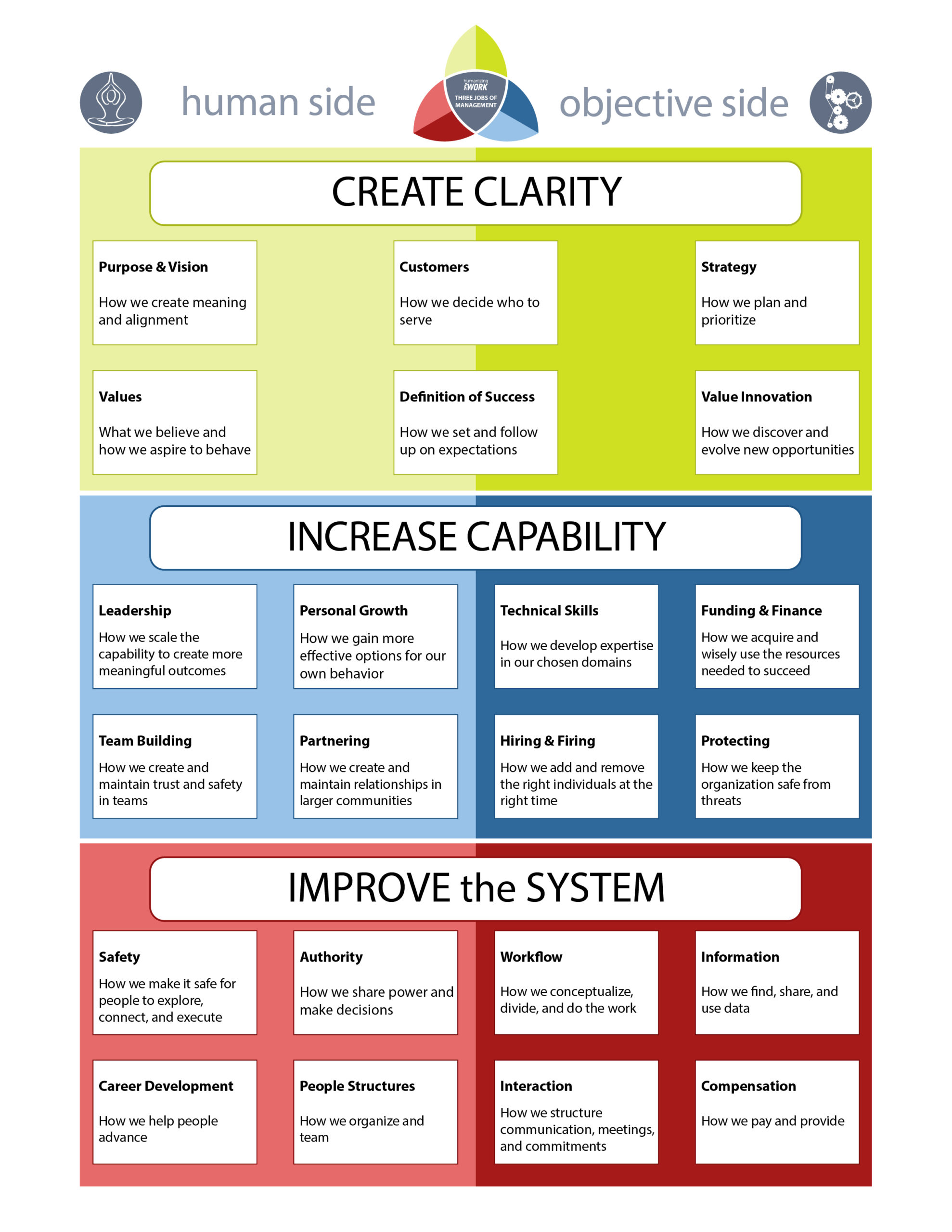In 2010, an animated drawing video illustrating a speech from author Dan Pink took the business world, and particularly the Agile community, by storm. In this speech, Pink shared the key ideas from his book, Drive: The Surprising Truth About What Motivates Us, Pink’s work summarized and applied 50 years of motivation research and boiled intrinsic motivation down town 3 easy-to-remember factors. Intrinsic motivation, Pink said, requires autonomy, mastery, and purpose. And that idea spread like crazy. Now, 13 years later, leaders everywhere know those 3 words, whether they’ve read the book or not.
Mastery is fairly straightforward to understand. It’s motivating to feel competent, to overcome challenges, and to experience growth. Purpose, too, is clear. We want our work to matter, to have an impact. Autonomy, however, is the complex and often misunderstood motivation factor.
Complex and Often Misunderstood
Autonomy means self-government. It’s the ability to choose what you do in your work, when you do it, and who you do it with. And yet, the relationship between autonomy and motivation isn’t straightforward in practice.
 Richard has surveyed classes for several years asking, “What motivates you in your work?” and “What demotivated you?” The answers to the first question almost completely revolve around purpose and mastery. Occasionally, someone who’s familiar with Drive will mention autonomy, but it’s rare. On the second question, “micromanagement” is the most common answer by far. It seems from this simple survey that autonomy only shows up the negative side. Few people cite being motivated by autonomy. Many people say they’re demotivated when their autonomy is constrained.
Richard has surveyed classes for several years asking, “What motivates you in your work?” and “What demotivated you?” The answers to the first question almost completely revolve around purpose and mastery. Occasionally, someone who’s familiar with Drive will mention autonomy, but it’s rare. On the second question, “micromanagement” is the most common answer by far. It seems from this simple survey that autonomy only shows up the negative side. Few people cite being motivated by autonomy. Many people say they’re demotivated when their autonomy is constrained.
Moreover, people report that it’s demotivating to have high autonomy but no clarity about what to do with it. That feels like floundering without direction.
Adding still more complexity to the notion of autonomy as a motivator is the fact that almost no one is completely autonomous. We give up choice in our work to others all the time in order to accomplish larger outcomes. Sometimes this is conscious, as when one person explicitly delegates a decision to someone else. Often it’s structural—hierarchies and roles create webs of interdependence and limited autonomy.
For example, on a Scrum team, a Product Owner gives up any claim to control over the team’s solution and a developer gives up control over the prioritization of the backlog. Each delegates some of their autonomy to the other.
Or consider a small group of teams working together on a large initiative. Even as individuals on those teams give up autonomy to each other based on their roles, those teams give up some autonomy to make it possible to accomplish a larger outcome than one team can achieve.
Clearly autonomy isn’t an all-or-nothing proposition. So what is a leader who wants to build an organization of motivated individuals to do?
Set Your People Up for Success
First, focus on purpose and mastery.
 For purpose, ensure that your people have clarity about the intended impact and definition of success for their work. More than that, make sure they can connect the dots between their work and the larger purpose it serves—this isn’t always obvious. (Creating this clarity, you may recall, is job #1 in the Humanizing Work 3 Jobs of Management model. It’s a big deal for leaders.)
For purpose, ensure that your people have clarity about the intended impact and definition of success for their work. More than that, make sure they can connect the dots between their work and the larger purpose it serves—this isn’t always obvious. (Creating this clarity, you may recall, is job #1 in the Humanizing Work 3 Jobs of Management model. It’s a big deal for leaders.)
For mastery, set your people up for success. Give them the tools and support they need to do their work well. Structure the work so they get frequent, useful feedback. Build in an appropriate balance between challenging and achievable, and help people rise to the challenge with space for experimentation and learning. Improve systems that get in the way of success. (Increasing capability and improving the system are, of course, jobs #2 and #3 in the 3 Jobs of Management model.)
Now, in that context with purpose and mastery in place, it’s time to focus on autonomy. The best way to get autonomy right is to ask, “What am I constraining that doesn’t need to be constrained?” Remember, complete autonomy isn’t the goal. The goal is to avoid limiting autonomy where it shouldn’t be limited. If you put constraints on how a team works, consider whether that constraint is really necessary.
Let’s look at an example…
Jill was recently hired as Director of Software Development at a large financial institution. In Jill’s last company, using an agile approach was just the way teams worked. Different teams used different techniques within that umbrella, but over the years, they had worked out a set of standard tools, expectations, and ways to plan and report on progress.
Her new organization, while generally using an agile approach to work, was less consistent across teams. Some seemed to be working well. Others used some of the agile words but rarely delivered software in small increments of value. Part of Jill’s mandate in her new role is to get these teams working more effectively.
So, at her first all hands meeting, she announces that, from now on, all teams will use a specific tool, estimate in a standard way, and provide the same reports to management about their work—the same tools and practices she used at her previous company. As she explained, these were the solutions they landed on after signifiant experimentation. Why go through that again?
However good her intentions, and whatever the merits of the specific tools and practices, Jill was met with a wave of resistance, complaining, and disengagement. Why? Because she’d constrained her teams in a way that took away their sense of autonomy over their work.
Instead, Jill should emphasize purpose and mastery and invite teams to use their autonomy to achieve a meaningful outcome. She might say something like this:
-
Our brand is one of the most respected names in finance, proven by our stock performance and our customer loyalty. We’re proud to stand on the shoulders of so many great people. As the world around us changes at breakneck pace, including how people think of finance and the role of technology in it, it is our turn to take the baton and evolve the company to be a modern, respected brand a generation from now.
Doing this will require that we find new ways to use technology internally and with our customers. We’ll need to develop new skills, not the least of which is the skill of experimenting to learn.
I’m sure there are things about the way we’ve been working that feel frustrating, old-fashioned, and bureaucratic to you. As we evolve our part of the organization, we’ll need to evolve not only what we make and the technology we use to make it, but how we organize, plan, team, and structure the work itself.
I trust that each of you will experiment with ways to improve all three: our products, our tech platform, and the culture of how we work. And since that level of change is hard, consider me your human snowplow. If you need help getting a change made to a process, tool, or to get an experiment approved and you’re not getting what you need from traditional channels, reach out to me directly and we’ll talk it through.
We’ll know we’re successful if a year from now, we’ve run 1,000 little experiments to see what works and shared the results, so that what we learn from those experiments is picked up by other teams. We’ll have a few constraints, like our budget, the 3 key deliverables on our roadmap that we talked through last week, and complying with regulators, but within those, you have my explicit permission to learn by experimenting.
If Jill uses this message to lay out what really matters to her about the particular solution she had in mind—what she was hoping the tools and practices she would have imported from her last company—she can have confidence that her organization of smart, engaged people will come up with a solution at least as good as that one. In fact, they’ll probably come up with a much better solution, perfectly adapted to their unique context.
Your Turn
Where is a place in your organization where you could focus on purpose and mastery to make space for greater autonomy and creativity from your teams? Email us to let us know how it goes!
By the way, this theme of increasing engagement and impact runs through all our courses. Are you ready to level up your effectiveness as a leader? Join us for an upcoming public workshop to level up your effectiveness as a leader, and subscribe to The Humanizing Work Show for more great content on increasing engagement and impact.
Last updated